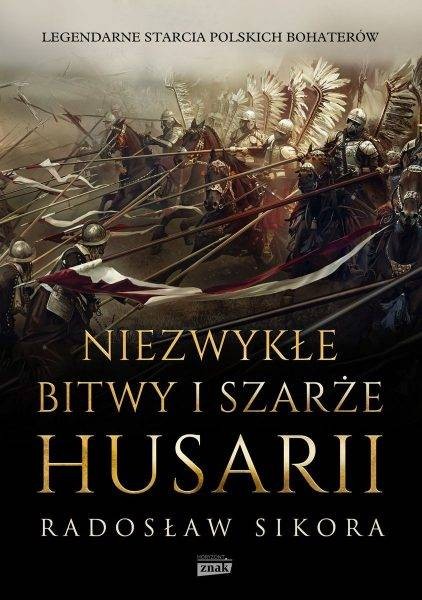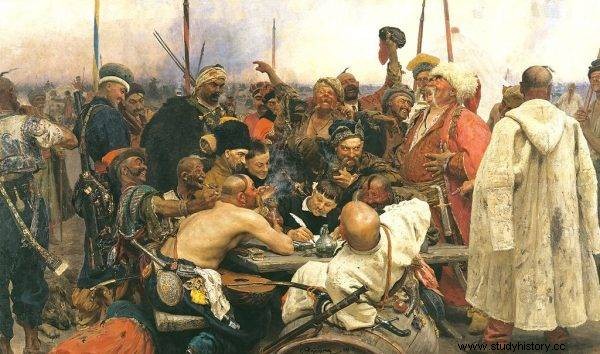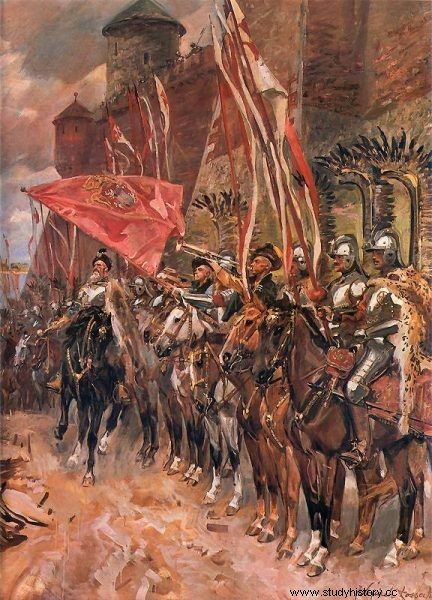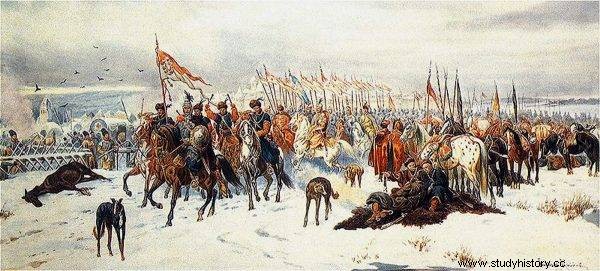In 1633, the Moscow army clashed with Polish knights near Smolensk. When the hussars caught up with their opponent in the open field, they proved their advantage again.
A year after the Battle of Krušyn, and 97 years after the Lithuanians lost Smolensk, the city again found itself within the borders of the Grand Duchy of Lithuania. Conquered in 1611 by the Muscovites, granted to the Commonwealth by the Divine Armistice (this was to apply from January 3, 1619 to July 3, 1633), it soon had to be defended by Lithuanians and Poles.
In 1632, taking advantage of the interregnum in Poland (Sigismund III Vasa, died on April 30, 1632), breaking the still-binding truce, a large Moscow army under the command of Mikhail Shein set off to recover what that commander had lost two decades earlier . He lost, because it was he who commanded the defense of Smolensk in the years 1609-1611. The army that Shein led was far from the one he had at his disposal two decades earlier.
Strength in infantry
The painful defeats that Moscow soldiers suffered in their clashes with the Polish and Lithuanian knights since the times of Stefan Batory pushed Muscovites to military reforms. They were modeled on Western European troops with their pikemen and musketeers, and above all with spears and hoes for digging earth obstacles that protected soldiers from the Polish and Lithuanian cavalry.
The effects of this modernization were impressive. But the Commonwealth did not fall asleep in the ashes either. After the recent experience of the war with the Swedes (a truce was concluded with them in Stary Targ in 1629), it was realized that a new type of war would require more infantry. So, as soon as a new king was elected, and it was Władysław, son of Zygmunt III Waza, particular emphasis was placed on recruiting infantrymen.

photo:Maciej Szczepańczyk / CC BY 3.0 So as soon as a new king was elected, and it was Władysław, son of Zygmunt III Waza, particular emphasis was placed on hauls of infantrymen.
Started in 1632, the war for Smolensk lasted until 1634, when Shein's army capitulated. The infantry played a major role in it, because:
Put the fields by no means [Muscovites] neither want nor think. But only under the cannon they stand at their stratagems, and they will not be allowed to stretch out further, only as long as their cannon covers them; you have to fight with them in Dutch and please do and dig and dig, like Gustav [Adolf] did .
Infantry was needed to dig apology, to break through tricks in the form of, for example, cobylits. Therefore, the hussars' participation in this campaign was limited.
No hussars move
Which doesn't mean it was useless yet. Its combat value was still rated very high. This is confirmed, for example, by the testimony of October 17, 1633:
[…] that lieutenant captain [in the Moscow service] , when he saw the ambulance, he was very surprised, he said, we are not afraid of Moscow, and as such payers, and as they call them, they do not pay in the camp. [iela] they did not respect anything, and they did not respect ours, p [owi] saying that a different bearing would be tempted to bale [they would hit them] ; y when he was told that it wasn't all the slots, because part of them with the Crown Hetman in the first regiment had gone, he said that you can not take such a stick. [iela] abolish and let go to the capital [Moscow].

The text is an excerpt from the newest book by Radosław Sikora, "Niez Niez Niezniany bitwy i graże husarii", which has just been published by the Znak Horyzont publishing house.
It is thanks to the high combat value of the hussars that its very presence influenced the enemy's behavior, which was carefully noted by one of the Polish sources:
The USSR did not stumble, because the enemy could not look at them from a distance, Moscow fled from the field immediately, when the USSR rushed towards them .
And when they went out into the open field…
Although the hussars did not fight much near Smolensk, in September 1633 they showed their class, breaking up the Western European and Moscow infantry of the Western European model. The fight was most accurately described by the participant of this war - Jan Moskorzowski:
Not hoping that the enemy would be able to break through on this side, which the Lithuanian army was guarding to break through, he stole from the Shehin's rolling stock (...) and was already Smolensk infantry from this rampart, in which he was driven out by XJM. Mr. Hetman of Lithuania [Krzysztof Radziwiłł] , being not far from this place at the time, he perceived, and could not so quickly be able to infantry on foot [the enemy] get away, nothing but the Usarius banners (...) he brought him, which liked pits and greeds, and uneven places struck, but the enemy was wiped out with great impetus and the valley was filled with corpses.

The Zaporozhets played a significant role in defeating the Russian army.
( The leg of those in the square ex confessione [from testimony] all enemy tongues of 400 people a), because after them they were bound together towards the Virgin Mountain and until in conspectum [in front of the face] the enemy's rides, which, however, did not dare to tempt us, came .
The clash took place in the northern outskirts of the Smolensk fortifications, on the hill marked on Hondius' engraving with number 116 (Dariusz Kupisz identified it as the Mushroom Mountain). It was there that gathered the Moscow army, consisting of six cavalry rotors and several hundred infantrymen. In total, probably about 1 thousand. soldiers.
Force comparison
Because, as a participant of this campaign wrote:"Moscow in all banners half of the conspirator, and Germans all musketeers", and since the sources mention only musketeers, it can be guessed that the vast majority of the infantry were mercenary foreigners in the service of the Muscovites . Jan Moskorzowski calls them "a powerful regiment of the fiery people."
In addition to them, he also sees "from other regiments of disguised people", and since the engravings, apart from the musketeers, also show pikemen, I believe that these "other regiments" are the so-called sołdate regiments, i.e. infantry composed of Moscow recruit, armed like Swedish and Dutch ( hence the spades) and commanded by Western European officers.

Three Hussar and one Cossack banners stood against this force.
Three Hussar and one Cossack banners stood against this force. Among the hussars there were Lithuanian royals:Tomasz Sapieha, the voivode of Novgorod, and Jakub Karol Madaleński of the army of Mścisław. The total full-time number of these four rots was around 480 horses. The actual number of Lithuanians is unknown, although must have been significantly lower than the full-time number because as Lithuanian chancellor Albrycht S. Radziwiłł wrote in those days,
through constant work and exposure to dangers, the number of Lithuanian soldiers has visibly decreased .
By the end of the following month, the Lithuanian army had only half the number of employees.
Massacre of walkers
Unfortunately, there are not many sources relating to this clash. Additional details, however, can be found in the diary compiled by Celewicz. It stated:
Our people began to rebuke them, beat them, chase them, and ran them over the bridge; in which Mr. Nowogrodzki voivodship with his banner attacked on foot, he struck it and caused great harm in them. Up to 500 were killed by the enemy, one of our companions killed a few shots; they fed up the horses .
So the information from Moskorzowski about the enemy's very high losses is confirmed. At the same time, these were losses of infantry, as the Moscow cavalry escaped without trying to face the hussars. Since there were several hundred walkers, and at least 400 of them died, it means that few walkers managed to escape from this massacre .

Smolensk rescue
It is also worth paying attention to the negligible losses of the attacking cavalry. One killed comrade and several shots with some (unspecified, but noticeable) horse losses once again confirm that the fire effectiveness of the firearms was still low, and the peaks were not able to stop the hussars.
"They got away quickly"
There is another source that describes these events. In an account published in Toruń in 1634, Henryk Chelchowski wrote:
will get better [Poles in the rampart] when you were a gentleman [mścisławski] somewhere on the side / with the voivod of Nowogrodzkie step / they will boldly add:/ They will bring Moscow back.
They ran away quickly, and ours followed them / chased:there and with their own people / Mr. Nowogrodzki wojewodzic is dearly / swam with pedestrians:until them [pedestrians] many fell .
All this is shown in the copperplate by Hondius - one of the very few sources illustrating the pikemen breaking by the hussars.
The disintegration of the pikemen-musketeer infantry once again proves that hussars in the open field still had no equal. However, both the wars with the Swedes waged in the 20s of the 17th century and the Smolensk war in the years 1632-1634 show that one could find a way for each formation. If you had no chance in the open field, you should not go into that field.
Source:
The text is an excerpt from the newest book by Radosław Sikora, "Niez Niez Niezniany bitwy i graże husarii", which has just been published by the Znak Horyzont publishing house.
